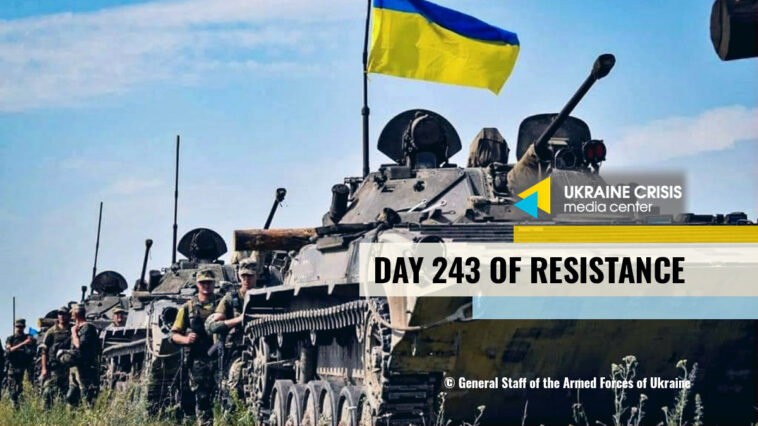Ukrainian troops advance in Donbas
The Ukrainian Armed Forces are gradually retaking the populated areas of Luhansk and Donetsk regions. The Ukrainian troops have pushed out the Russian forces from Karmazynivka, Myasozhrivka and Nevske in Luhansk region, and Novosadove in Donetsk region, the General Staff of the Ukrainian Armed Forces said in an evening report on October 24.
In the past day, Ukraine’s defense forces repelled the Russian attacks in the area of Spirne, Soledar, Bakhmut, Andriyivka, Maryinka, and Pervomayske, the General Staff of the Ukrainian Armed Forces said. The Russian forces continue to be on the offensive on the Bakhmut and Avdiyivka axes.
There’s an extremely tense situation on the Bakhmut axis, but the Russian forces are steadily losing ground, head of the Donetsk regional military administration Pavlo Kyrylenko said in a news conference on Monday, October 24.
“The situation in Bakhmut and on the Bakhmut axis overall remains extremely tense. All attempts by the Russians to enter the city and break the defense of the Ukrainian troops fail. The enemy forces come under fire and lose ground every day. They take losses in personnel,” Kyrylenko said.
Iran to supply body armor, missiles to Russia, Ukraine’s defense intelligence says
Being unwilling to issue gear to newly mobilized, Russia began to use Iranian-made supplies, the Main Intelligence Department of Ukraine’s Ministry of Defense said.
“Being unwilling to issue domestic gear to a new wave of the draftees, Russia began to use Iranian-made gear. [Iran] will send 3,000 body armor items in the nearest time, including 1,500 vests and 1,500 Milad helmets,” Ukraine’s defense intelligence said.
Iranian-made supplies are stored at the depot no.1061 at the base supply center of the 3rd motor rifle division in Soloti/Valuiki in Russia’s Belgorod oblast.
Iran also plans to send a new team to Russia to advise on the combat use of a new type of drones Arash-2 and Iranian-made surface-to-surface missiles, Ukraine’s defense intelligence said.
A group of the Islamic Revolutionary Guard Corps is on the way to Dzhankoy to train the Russians to use the Shahed-136 and Mohajer-6 drones.
Russian forces preparing to defend Kherson, not to withdraw, Ukraine’s defense intelligence says
The Russian forces create the illusion that they are leaving Kherson. Instead they are sending in reinforcement and prepare for defense in the occupied city, head of the Main Intelligence Department of the Ministry of Defense of Ukraine Kyrylo Budanov said in an interview with Ukrainska Pravda.
Sergey Surovikin, the commander of Russia’s forces in Ukraine might be preparing to curb discontent at home if the Russians lose control of Kherson, but saying that “they are fleeing Kherson” would be wrong, Budanov said. “That is an information operation and manipulation in many aspects. There are certain facts. They remove Promsvyazbank and other financial structures that the Russians installed there.”
“They take away cash, servers, move out the occupation authorities, people who can’t move without assistance, and heavily wounded. Those who can walk are discharged from hospitals. They are holding the massive information campaign to say ‘we care about the people’ etc.”
“They are creating the illusion that everything is lost. At the same time they are bringing in more troops and preparing the streets for defense,” Budanov said.
Podcast Explaining Ukraine. Dostoevsky, crime, justice, and Russia’s war in Ukraine, with Fiction/Non/Fiction podcast
This episode of the Explaining Ukraine podcast is made in partnership with Fiction/Non/Fiction podcast. With this podcast’s hosts V.V. Ganeshananthan and Whitney Terrell we discuss the Russian invasion of Ukraine through the lens of Fyodor Dostoevsky’s Crime and Punishment. We talk about how Russian literature and Russian culture have separated crime from punishment, creating a society that distrusts laws and regulation, and values power and impunity. “Explaining Ukraine” hosts: Volodymyr Yermolenko, a Ukrainian philosopher and journalist, and chief editor of UkraineWorld.org, and Tetyana Ogarkova, who heads the international department of Ukraine Crisis Media Centre.
Podcast Explaining Ukraine. Looming environmental disaster in Ukraine’s south. – Weekly digest, 16-23 Oct
Russian troops are preparing for street fighting in Kherson, as they cannot hold back the Ukrainian counteroffensive in the South. There is a risk that they will blow up the dam at the Nova Kakhovka hydroelectric power plant, provoking one of the worst environmental disasters in Eastern European history. Learn more from the weekly digest of our Explaining Ukraine podcast. Hosts: Volodymyr Yermolenko, Ukrainian philosopher and journalist, chief editor of UkraineWorld.org, and Tetyana Ogarkova, Ukrainian scholar and journalist, in charge of international outreach at the Ukraine Crisis Media Centre.
Women on the frontline of Russian-Ukrainian war. Ukraine in Flames #227
According to the Deputy Minister of Defense Hanna Malyar, more than 38 thousand women serve in the Armed Forces of Ukraine, and 7 thousand of them joined the army after the start of the full-scale invasion. Absolutely majority of those brave Ukrainians joind the army volunterily, by choice. Watch Ukraine in flames #227 to learn why and when they decided to serve, if gender matters on the frontline, and what it means to be a woman in the active warzone.
Guests:
- Yuliia “Taira” Paievska, a well-known Ukrainian paramedic, recently was released from Russian captivity
- Olena Bilozerska, Sniper and participant in the Russian-Ukrainian war since 2014
- Alina Sarnatska, first aid responder, Ukrainian Armed Forces (manager of a public organization and postgraduate student of social work in her civilian life)
- Nata Kit, voluntary serves in Ukrainian Armed Forces (director and producer in her civilian life)




